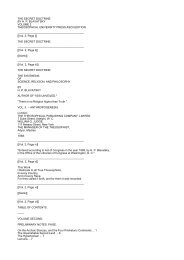Create successful ePaper yourself
Turn your PDF publications into a flip-book with our unique Google optimized e-Paper software.
The Abode Of The Blessed.<br />
Sacred Texts Egypt Index Previous Next<br />
THE ABODE OF THE BLESSED.<br />
The Egyptian heaven.<br />
The gods <strong>of</strong> <strong>the</strong> Egyptians dwelt in a heaven with <strong>the</strong>ir ka's, and khu's, and shadows, and <strong>the</strong>re <strong>the</strong>y<br />
received <strong>the</strong> blessed dead to dwell with <strong>the</strong>m. This heaven was situated in <strong>the</strong> sky, which <strong>the</strong> Egyptians<br />
believed to be like an iron ceiling, ei<strong>the</strong>r flat or vaulted, and to correspond in extent and shape with <strong>the</strong><br />
earth beneath it. This ceiling was rectangular, and was supported at each corner by a pillar; in this idea,<br />
we have, as M. Maspero has observed, a survival <strong>of</strong> <strong>the</strong> ro<strong>of</strong>-tree <strong>of</strong> very primitive nations. At a very<br />
early date <strong>the</strong> four pillars were identified with "<strong>the</strong> four ancient khu's who dwell in <strong>the</strong> hair <strong>of</strong> Horus,"[1]<br />
who are also said to be "<strong>the</strong> four gods who stand by <strong>the</strong> pillar-sceptres <strong>of</strong> heaven."[2] These four gods are<br />
"children <strong>of</strong> Horus,"[3] and <strong>the</strong>ir names are Amset, Hapi, Tuamautef, and Qebhsennuf.[4] They were<br />
supposed to preside over <strong>the</strong> four quarters <strong>of</strong> <strong>the</strong> world, and subsequently were acknowledged to be <strong>the</strong><br />
gods <strong>of</strong> <strong>the</strong> cardinal points. The Egyptians named <strong>the</strong> sky or heaven pet. A less primitive view made <strong>the</strong><br />
heavens in <strong>the</strong> form <strong>of</strong> <strong>the</strong> goddess Nut who was represented as a woman with bowed body whose hands<br />
and feet rest on <strong>the</strong> earth. In this case <strong>the</strong> two arms and <strong>the</strong> two<br />
[1. ###. Recueil de Travaux, t. iv., p. 55 (l. 473); and compare ###. Ibid., t. v. p. 186 (l. 171).<br />
2. Ibid., t. v., p. 27 (1. 233).<br />
3. Ibid., p. 39 (l. 281).<br />
4 Ibid., p. 10 (l. 60).]<br />
{p. cii}<br />
The Egyptian heaven.<br />
legs form <strong>the</strong> four pillars upon which <strong>the</strong> heavens are supported. Nut, <strong>the</strong> sky goddess, was <strong>the</strong> wife <strong>of</strong><br />
Seb, <strong>the</strong> earth god, from whose embrace she was separated by Shu, <strong>the</strong> god <strong>of</strong> <strong>the</strong> air; when this<br />
separation was effected, earth, air, and sky came into being. Signor Lanzone has collected a number <strong>of</strong><br />
illustrations <strong>of</strong> this event from papyri and o<strong>the</strong>r documents,[1] wherein we have Seb lying on <strong>the</strong> ground,<br />
and Shu uplifting Nut with his outstretched hands. The feet <strong>of</strong> <strong>the</strong> goddess rested on <strong>the</strong> east, and her<br />
hands on <strong>the</strong> west this is shown by <strong>the</strong> scene wherein Shu is accompanied by two females who have on<br />
<strong>the</strong>ir heads "east" and, "west" respectively.[2] The child <strong>of</strong> <strong>the</strong> union <strong>of</strong> Seb and Nut was <strong>the</strong> Sun, who<br />
was born in <strong>the</strong> east in <strong>the</strong> morning, and who made<br />
[1. Dizionario di Mitologia Egizia, tavv. i 150 ff.<br />
2. Ibid., tav. 158.]<br />
{p. ciii}<br />
The Egyptian heaven.<br />
his course along his mo<strong>the</strong>r's body, until he set in <strong>the</strong> west in <strong>the</strong> evening. The moon followed <strong>the</strong> sun's<br />
http://www.sacred-texts.com/egy/ebod/ebod08.htm (1 <strong>of</strong> 4) [8/10/2001 11:23:43 AM]

















